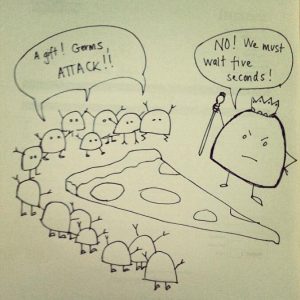Friend of the barfblog.com Don Schaffner of Rutgers is having his pop-science moment in the sun.
Press release before peer-review, whatever faults peer-review has, is a bad idea.
(My previous lab had our moment in 2004 when we trashed food safety practices on TV cooking shows; it was peer-reviewed before we talked about it.)
So Schaffner and graduate student Robyn Miranda, waited until their results were published, and then destroyed the 5-second rule: you know, food is safe if it’s on the floor for less than 5-seconds.
Christopher Melesept of the N.Y. Times reports a new study debunks the so-called five-second rule.
Professor Donald W. Schaffner, a food microbiologist at Rutgers University in New Jersey, said a two-year study he led concluded that no matter how fast you pick up food that falls on the floor, you will pick up bacteria with it.
The findings in the report — “Is the five-second rule real?” — appeared online this month in the American Society for Microbiology’s journal,Applied and Environmental Microbiology.
Researchers at Aston University’s School of Life and Health Sciences in England reported in 2014 that food picked up a few seconds after being dropped is “less likely to contain bacteria than if it is left for longer periods of time,” giving rise to news accounts suggesting that eating the food might be harmless. Those findings, and research done at the University of Illinois in 2003, did not appear in a peer-reviewed journal, Professor Schaffner noted.
Even though the five-second rule is a bit of folklore, it still raised important public health issues that demanded closer scrutiny, he said. He cited research by the Centers for Disease Control, which found that surface cross-contamination was the sixth most common contributing factor out of 32 in outbreaks of food-borne illnesses.
 Professor Schaffner and a master’s thesis student, Robyn C. Miranda, tested four surfaces — stainless steel, ceramic tile, wood and carpet — and four different foods: cut watermelon, bread, buttered bread and strawberry gummy candy. They were dropped from a height of five inches onto surfaces treated with a bacterium with characteristics similar to salmonella.
Professor Schaffner and a master’s thesis student, Robyn C. Miranda, tested four surfaces — stainless steel, ceramic tile, wood and carpet — and four different foods: cut watermelon, bread, buttered bread and strawberry gummy candy. They were dropped from a height of five inches onto surfaces treated with a bacterium with characteristics similar to salmonella.
The researchers tested four contact times — less than one second and five, 30 and 300 seconds. A total of 128 possible combinations of surface, food and seconds were replicated 20 times each, yielding 2,560 measurements.
The research found that the five-second rule has some validity in that longer contact times resulted in transfer of more bacteria. But no fallen food escaped contamination completely. “Bacteria can contaminate instantaneously,” Professor Schaffner said in a news release.
Carpet had a very low rate of transmission of bacteria compared with tile and stainless steel; transfer rates from wood varied.
The composition of the food and the surface on which it falls matter as much if not more than the length of time it remains on the floor, the study found. Watermelon, with its moisture, drew the highest rate of contamination and the gummy candy the least.
In an interview, Professor Schaffner said, “I will tell you on the record that I’ve eaten food off the floor.” He quickly added: “If I were to drop a piece of watermelon on my relatively clean kitchen floor, I’m telling you, man, it’s going in the compost.”
The history of the five-second rule is difficult to trace but it is attributed apocryphally to Genghis Khan, who declared that food could be on the ground for five hours and still be safe to eat, Professor Schaffner said.
William K. Hallman, an experimental psychologist and a professor at the Department of Human Ecology at Rutgers University, said people do not put every decision through a risk-benefit filter and instead rely on cognitive shortcuts called heuristics to help in their daily lives.
“It’s a way of making a very quick decision with whatever data is available,” he said in an interview.
But sometimes those shortcuts can be based on flawed assumptions or missing information.
For instance, germs are invisible and so they are easy to ignore when “something of particular value, like a yellow peanut M&M” falls to the floor, he said. Because germs are out of sight, the belief is there is no harm in picking up the M&M and popping it in your mouth.
 Douglas Powell, a former professor of food safety and the publisher of barfblog.com about food safety, added that people eat from the floor because they are told not to waste food.
Douglas Powell, a former professor of food safety and the publisher of barfblog.com about food safety, added that people eat from the floor because they are told not to waste food.
People are also impervious to risk. “I’ve done this all my life and never gotten sick; I did this a couple of days ago and nothing happened,” he said in an email.
Or as Professor Schaffner observed: “The first kid, the pacifier falls on the floor, oh my God, we have to sterilize it. By the third kid, it’s like ‘whatever.’ ”
Research has shown that people think germs belong to other people, Professor Hallman said. For instance, people generally believe their bathrooms are cleaner than a public restroom. In fact, that is not the case because public restrooms are cleaned more regularly, he said in an interview.
People also misunderstand the transmission of germs.
“We sort of joke about the five-second rule, but people act as if germs take some period of time to race to the item that fell on the floor,” he said.
People also do not recognize the symptoms of food-borne illnesses and tend to blame them on the last thing they ate, so they do not connect how their earlier actions might have made them sick.
 Are men more likely to eat off the floor than women?
Are men more likely to eat off the floor than women?
Yes, according to Professor Hallman. In contrast to women, men say they more frequently engage in behaviors such as picking up food or a fork that has fallen to the floor, or picking an insect or a hair out of their food then continuing to eat, he said. The findings came from a phone survey of 1,000 Americans in 2005.
Anthony Hilton, a professor of microbiology at Aston University, said a survey of nearly 500 people found 81 percent of women said they followed the rule — they would not eat anything that lingered on the floor — compared with 64 percent of men, the magazine “Scientific American” reported.
“Hilton says he doesn’t have a good explanation for this gender differentiation but points out that this finding is consistent with other research into the five-second rule,” the magazine wrote. “One possible conclusion: This is tacit confirmation of another piece of folk wisdom — men are less discerning when it comes to their food’s cleanliness.”

